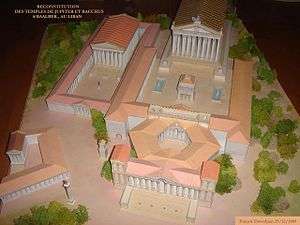Temple of Jupiter (Roman Heliopolis)
| Temple of Jupiter | |
|---|---|
|
Temple of Jupiter on top of the Heliopolis Sanctuary | |
| General information | |
| Type | Roman temple |
| Architectural style | Classical |
| Location |
Baalbek, Lebanon Heliopolis, Roman Phoenicia |
| Construction started | first century |
| Completed | late 2nd or early 3rd century |
| Height | 95 m (312 ft) |
| Technical details | |
| Size | 90 by 54 m (295 by 177 ft) |
| Design and construction | |
| Architect | Unknown |
| Main contractor | Commissioned by Augustus |
The Temple of Jupiter (Roman Heliopolis) was a colossal temple dedicated to the cult of Zeus, located in Heliopolis of Roman Phoenicia (Baalbeck of modern Lebanon). It was the main building in a huge "Great Court" (or "Sanctuary") of a Roman pagan temple complex that still partially stands.[1]
History
The Temple of Jupiter in Heliopolis (in a complex area called even Sanctuary of Heliopolitan Zeus) presumably replaced an earlier Phoenician one that used the same foundation. The presence of a huge quarry was one of the reasons for the Roman decision to create a huge "Great Court" of a big pagan temple complex in this mountain site, located at nearly 1100 meters of altitude and on the eastern Borders of the Roman Empire: it took three centuries to create this colossal Roman paganism's temple complex.
On a single E-W axis almost 400 m long, the sanctuary of Heliopolitan Jupiter includes monumental propylaea, a hexagonal court, a large rectangular court, and the temple proper, where the cult idol was enthroned under a canopy in the cella.The sanctuary occupies an ancient tell, artificially enlarged by enormous works of terracing and masonry. At the W end near the N corner, the supporting walls contain three colossal quadrangular stones, called the "Trilithoi", each one nearly 20 by 4.5 by 3.6 m. Another even larger stone was left in a quarry at the foot of the hill W of the town. Two long vaulted galleries running E-W correspond at the basement level to the peristyle of the central court. They are open at the ends and joined by a transverse gallery. Some of their keystones carry Latin inscriptions. J.Rey-Coquais
The Temple of Jupiter —once wrongly credited to Helios[2]— lay at the western end of the Great Court of Roman Heliopolis. It raised another 7 m (23 ft) on a 47.7 m × 87.75 m (156.5 ft × 287.9 ft) platform reached by a wide staircase.[3]
This temple was dedicated to the Roman Zeus and the construction was started by Julius Caesar and continued later by Augustus: it was the biggest pagan temple dedicated to Jupiter in all the Roman empire. The columns were 30 meters high with a diameter of nearly 2.5 meters: the biggest in the classical world.
Under the Byzantines, it was also known as the "Trilithon" from the three massive stones in its foundation and, when taken together with the forecourt and Great Court, it is also known as the "Great Temple".[4] The Temple of Jupiter proper was circled by a peristyle of 54 unfluted Corinthian columns:[5] 10 in front and back and 19 along each side.[3]
The Temple-Sanctuary of Heliopolitan Zeus was ruined by earthquakes,[6] destroyed and pillaged for stone under Theodosius,[7] and 8 columns were taken to Constantinople (Istanbul) under Justinian for incorporation into the Hagia Sophia. Three fell during the late 18th century.[8] 6 columns, however, remain standing along its south side with their entablature.[3] Their capitals remain nearly perfect on the south side, while the Beqaa's winter winds have worn the northern faces almost bare.[9] The architrave and frieze blocks weigh up to 60 tonnes (66 tons) each, and one corner block over 100 tonnes (110 tons), all of them raised to a height of 19 m (62.34 ft) above the ground.[10] Individual Roman cranes were not capable of lifting stones this heavy. They may have simply been rolled into position along temporary earthen banks from the quarry[9] or multiple cranes may have been used in combination. They may also have alternated sides a little at a time, filling in supports underneath each time.
The Julio-Claudian emperors enriched its Sanctuary in turn. In the mid-1st century, Nero built the tower-altar opposite the temple. In the early 2nd century, Trajan added the temple's forecourt, with porticos of pink granite shipped from Aswan at the southern end of Egypt.
See also
Notes
- ↑ Video of the actual Temple of Jupiter and the Sanctuary
- ↑ Cook (1914), p. 565.
- 1 2 3 Cook (1914), p. 560.
- ↑ EB (1911), p. 90.
- ↑ Jessup (1881), p. 460.
- ↑ Cook (1914), p. 556.
- ↑ Cook (1914), p. 555.
- ↑ EB (1878), p. 177.
- 1 2 Jessup (1881), p. 462.
- ↑ Coulton (1974), p. 16.
Bibliography
- Cook, Arthur Bernard (1914), Zeus: A Study in Ancient Religion, Vol. I: Zeus God of the Bright Sky, Cambridge: Cambridge University Press.
- Coulton, J.J. (1974), "Lifting in Early Greek Architecture", Journal of Hellenic Studies, Vol. 94.
- Jessup, Samuel (1881), "Ba'albek", Picturesque Palestine, Sinai, and Egypt, Div. II, New York: D. Appleton & Co., illustrated by Henry Fenn & J.D. Woodward, pp. 453–476.

